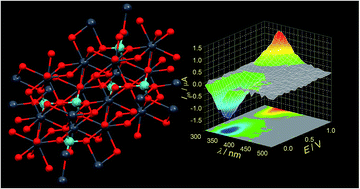Lead molybdate – a promising material for optoelectronics and photocatalysis†
Abstract
The growing interest in the use of light as an information and energy carrier has led to an increasing demand for new materials, characterised by particular photoelectrochemical properties. The aim of this work is to introduce a wide band gap semiconductor – PbMoO4 with a detailed description of its synthesis procedure and product characterisation. The emphasis was put on its electronic structure and photoelectrochemical properties in order to evaluate the mechanism of the photoelectrochemical photocurrent switching effect (the PEPS effect). This phenomenon may be utilized in the construction of simple logic devices (e.g. logic gates or switches) or more complex optoelectronic circuits. Lead molybdate in the form of fine powder was obtained via a microwave assisted hydrothermal route. It was found that the composition of the reaction mixture (i.e. the ratio between lead and molybdate ions) influences the morphology and the electronic structure of the semiconductor. The photoelectrochemical characterization revealed that PbMoO4 in the presence of the Ce4+/Ce3+ redox couple exhibits the PEPS effect regardless of the presence of oxygen in the electrolyte. This may be explained in terms of oxidation/reduction processes of cerium(III)/cerium(IV) species. An attempt to modify the surface via the adsorption of alizarin onto PbMoO4 was also made. The spectroscopic characterization and DFT calculations performed for such an organic–inorganic hybrid material revealed that the dye binds to MoVI centres which are exposed on the surface. Alizarin adsorbed onto PbMoO4 strongly enhances the cathodic photocurrent generation. At the same time, however, the anodic photocurrent diminishes. Therefore, literally no switching effect occurs for such a system. Nonetheless, the generation of intense cathodic photocurrent may be utilized in photocatalysis, e.g. during the photoreduction of metal ions or the generation of reactive oxygen species and/or solar fuels.


 Please wait while we load your content...
Please wait while we load your content...